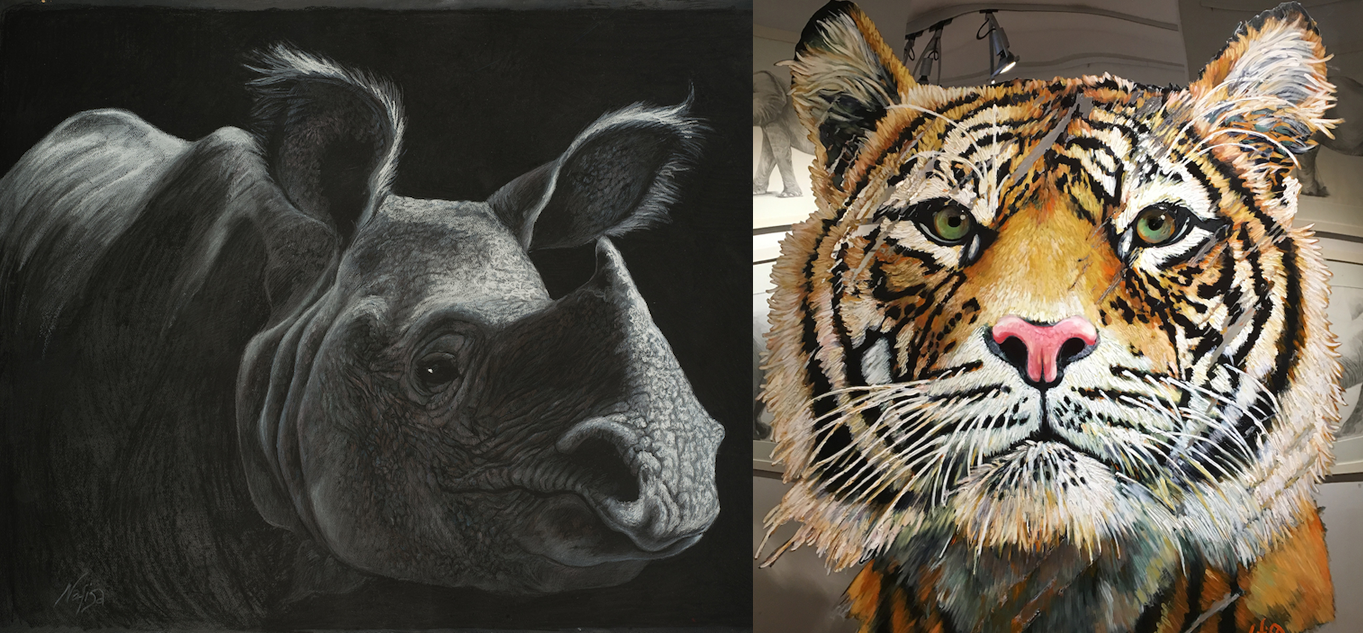When I was given the opportunity to write a blog for Animal Works, I was delighted. After all, with a passion for wildlife and conservation, what better way to share my thoughts and knowledge than through a well known organisation’s website, such as Animal Works, who are dedicated to conservation through education? But before I leap in head first, throwing knowledge and opinions around cyberspace, I think I should give you a snapshot of my background, without sending you to sleep.
Like most children, I grew up loving animals and the great outdoors. Numerous furry, feathered, scaly and hooved creatures accompanied me throughout my childhood, and still do. I loved to climb trees (and occasionally fall out of them, much to my mother’s horror), lie still for hours on the grass, absorbed in the busy microcosm of the insect world, and save drowning ladybirds from swimming pools. I used to cry when I saw baby seals getting clubbed on television, lions getting shot, and even clear-felling of trees. I felt an innate connection to the natural world, even as a child, and as a young woman, I considered myself a ‘greenie’, minus the dreadlocks.
I watched the environmental movement grow throughout the 80s and 90s. I observed other greenies (often with dreadlocks) protest against the Franklin Dam in Tasmania; uranium mining at Roxby Downs; nuclear testing in Mururoa Atoll; and the Jabiluka Uranium mine site. I witnessed a younger Greenpeace become more and more influential. And I saw a fledgling Sea Shepherd become more and more popular. I admired their gumption and their bravery. I wanted to be a part of it. I wanted to defend our planet. What humankind were doing to our fragile planet was (and still are) is intrinsically wrong and incredibly detrimental. How could (and can) people not see that?
However, one thing that struck me the most, back in the day, was the general public’s perception of these ‘greenies’ trying to ‘save the world’. It wasn’t positive. Most of the general public dismissed the protesters as, ‘dole bludging hippies with nothing better to do’, ‘dope-smoking do-gooders’, and ‘no-hopers that need a good bath’. I’ve lost count of the times that I tried to defend those very protesters, pointing out that what they are doing is altruistic; they are thinking of our future generations; and they are not thinking of their own hip pocket, unlike most other people in the world. I ended up remaining silent, as I discovered that people would argue vehemently against those ‘useless greenies’ and would never back down. There was no point in arguing with them. They wouldn’t listen. Oddly, it seemed to be a very touchy subject for many people.
But I decided what people needed was a different ‘type’ of ‘greenie’. A well-groomed, educated professional greenie, whom people would take seriously, whom people would listen to, and respect. Someone who could potentially change policies on environmental issues in government or be able to educate future generations. Because I believe that education is the key to saving the planet, future generations are the only ones who can remedy the damage we have already done to the planet. Of course, there are many ‘greenies’ out there like that now, thank goodness, and I believe that has helped change the perception of the environmental movement, and has encouraged the general public to take environmental issues far more seriously.
So I completed my Bachelor of Applied Science in Ecotourism in 2003, which further fanned my flames of passion for wildlife and conservation, and then completed my Master of International Relations and National Security in 2012 with my thesis based on Transnational Organised Crime Networks and the Illegal Wildlife Trade.
Now, I am ashamed to say that with all of my interest over the years in wildlife and conservation, I knew nothing about the illegal wildlife trade. I literally stumbled across the topic whilst on holiday in Thailand reading a paper on a local bus. It was a tiny snippet of news somewhere in the middle of the paper, only about five sentences long, about some poacher who had been caught and convicted of poaching some poor innocent endangered animals, then let off with little more than a smack on the hand. My interest was piqued. On my return home, I looked into the topic further and discovered that is a cruel, multi-billion dollar global industry, and decided to do my Master’s thesis on it. For nearly a year whilst researching, I spent each and every day crying over my laptop, horrified and despairing at the barbarity and heartlessness of human beings.
Currently I teach International Relations at university as a Sessional Lecturer, and try to educate the students about conservation and environment where I can within the curriculum. This year, I hope to start my PhD based on the impact of the illegal wildlife trade on the environment, with the objective to open as many doors as I can, change as many minds as I can, and influence as many people as I can regarding the illegal wildlife trade and conservation and wildlife in general.
Nature conservation is a massive field, encompassing an endless array of issues and challenges such as: ecosystems; biodiversity; climate; forests; oceans; wildlife; poaching; the illegal wildlife trade; environmental crime; and habitat loss, just to name a few. Animal Works focuses on conservation through education; something I plan to write regularly about on their blog, on issues and current projects such as habitat loss, human-wildlife conflict and solutions, orphaned wildlife care, and poaching. I look forward to writing interesting and educational blogs for you, the reader, and I hope you enjoy my upcoming pieces.










































